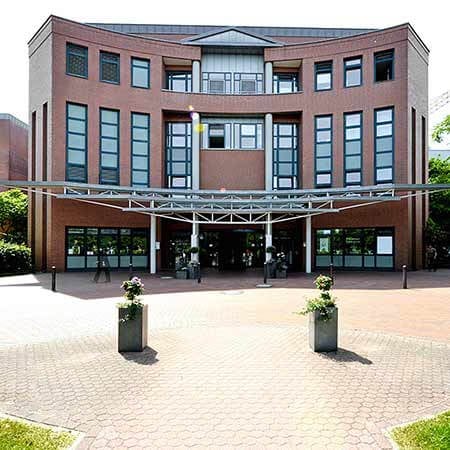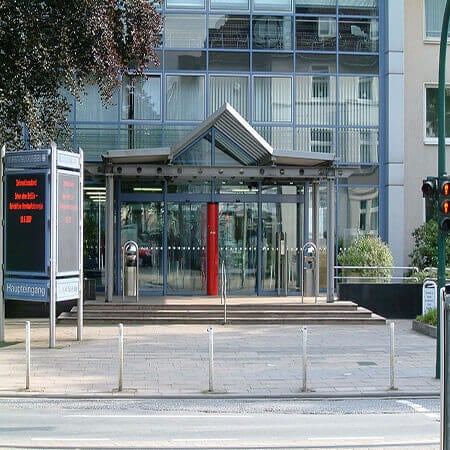Tricuspid stenosis is a narrowing of the tricuspid valve opening. This defect is very rare. Even less often it is isolated, that is, developing without a combination with damage to other heart valves. The most common cause of pathology is rheumatism. The correction of the defect in Europe involves the use of both open surgical interventions and minimally invasive transcatheter procedures.
Content
- What is tricuspid stenosis
- Symptoms
- Diagnostics
- Treatment principles
- Surgical commissurotomy
- Balloon commissurotomy
- Tricuspid valve replacement
- Repeated minimally invasive tricuspid valve replacement
- Why it is worth undergoing treatment abroad
- Treatment in Europe at an affordable price
What is tricuspid stenosis
The heart has four chambers: two atria and two ventricles. The left and right halves of the heart do not communicate with each other, but each atrium is connected to the ventricle through the atrioventricular orifice. There is a valve in this orifice that causes blood to move in only one direction: from the atria to the ventricles. During heartbeat, the valves close, thereby preventing blood from flowing back into the atrium.
There is a mitral valve in the left half of the heart, and a tricuspid valve in the right half. Heart disease can cause the tricuspid valve opening to narrow. This condition is called stenosis. Normally, the valve area should be 3.5-4 square centimeters. With stenosis, its size decreases, and the narrower the right atrioventricular orifice becomes, the more difficult it is for the heart to push blood through it.
The severity of tricuspid valve stenosis, depending on the area of the opening:
- Grade 1 – 3-3.5 cm2.
- Grade 2 – 1.5-3 cm2.
- Grade 3 – less than 1.5 cm2.
The most common cause of tricuspid valve stenosis is rheumatism. As a rule, this disease also damages other heart valves, so isolated tricuspid stenosis is rare.
Other causes of the defect besides rheumatism may include:
- Endocarditis – inflammation of the inner lining of the heart, usually of an infectious origin.
- Neoplasms or large blood clots in the right atrium.
- Congenital heart disease.
- Previous surgical interventions on the heart and transcatheter procedures.
Severe tricuspid valve stenosis affects the health of all organs. With this defect, the systemic circulation suffers from blood stagnation, so the tissues receive less oxygen.
Symptoms
In most cases, the defect has no specific symptoms. There are two reasons for this:
- Tricuspid stenosis is rarely severe.
- Even if patients suffer from severe stenosis, the mitral valve is usually affected at the same time, and the symptoms of this defect dominate the clinical picture of the disease.
If symptoms do occur, the most common patient complaints are as follows:
- Heart palpitations, sinking heart, irregular heartbeat.
- Weakness, fatigue.
- Pain or discomfort in the liver area due to blood stasis.
- Shortness of breath that gets worse with physical exertion.
The severe tricuspid valve stenosis causes swelling of the legs and cervical veins, as well as liver enlargement. Palpation can determine the pulsation of the liver and cervical veins. In the advanced stage of pathology, fluid accumulates in the abdominal cavity. This condition is called ascites. It is accompanied by an increased volume of the abdomen.
Diagnostics
As for the diagnostics of other heart defects, echocardiography is considered the main method of examination for tricuspid valve stenosis. This diagnostic test is simple, inexpensive and safe for health, since it does not require the administration of contrast agents and does not cause radiation exposure to the body. The doctors in developed countries often conduct three-dimensional echocardiography, which provides more accurate diagnostic results.
Echocardiography allows assessing the following:
- Condition of the heart valves, including their area, condition of the leaflets, both speed and direction of blood flow.
- Condition of the chambers of the heart (atria and ventricles).
- Presence of pulmonary hypertension.
Echocardiography can roughly measure the pressure in the pulmonary artery. If it is more than 50% higher than the systemic one, then specialists perform an invasive study – cardiac catheterization. The diagnostic procedure makes it possible to accurately measure the pressure in the pulmonary artery, and this indicator is important for the choice of therapeutic tactics. Pulmonary hypertension is considered a risk factor for surgery.
Coronary angiography can be conducted additionally, if clinically indicated. This is a contrast-enhanced study of the coronary vessels of the heart. The procedure is invasive, as it requires arterial bed catheterization. The indications for this study are as follows:
- Presence of symptoms of coronary heart disease (angina attacks).
- Male gender and age over 45.
- Female gender and age over 50.
In Europe, a CT scan is often used instead of coronary angiography. The technique allows doctors to assess coronary blood flow using intravenous contrast enhancement.
Treatment principles
The key principles for the treatment of tricuspid valve stenosis are as follows:
- Drug therapy is minimally effective: it only relieves the symptoms of heart failure, but does not increase life expectancy. The basis of therapy is diuretics.
- The main operation for the correction of tricuspid stenosis is surgical commissurotomy.
- Minimally invasive balloon commissurotomy is safer, but less effective, and therefore it is used mainly in those who are contraindicated for open surgery.
- Most patients with tricuspid stenosis also require intervention on other valves, most often on the mitral valve.
- For tricuspid valve replacement, doctors mainly use biological prostheses, since the implantation of mechanical ones often causes the development of thromboembolic complications.
- Repeated valve replacement surgery after wear of the bioprosthesis can be performed using the minimally invasive transcatheter method.
Surgical commissurotomy
Commissurotomy is a surgical intervention, the essence of which is the dissection of commissures. These are the sites where the valve leaflets meet. After commissurotomy, the valve area increases, so the manifestations of valvular stenosis regress.
In most patients, the surgical intervention is performed through a large incision in the thorax, under the conditions of artificial circulation. The objectives of the surgery are as follows:
- Increasing valve mobility.
- Ensuring a sufficient area of their contact when closing the valve, so that there is no tricuspid insufficiency.
- Sometimes there is a need for additional stabilization of the annulus fibrosus – the opening that closes the valve leaflets (in some patients, stenosis is combined with tricuspid insufficiency).
Isolated tricuspid stenosis is rare. In most cases, it is combined with mitral stenosis. Therefore, the surgical intervention also usually involves a single-stage commissurotomy on the mitral valve. The doctor restores leaflet mobility and removes blood clots. The left atrial appendage is often amputated to avoid future blood clots. This manipulation reduces the risk of thromboembolism, including ischemic stroke.
Balloon commissurotomy
With mitral valve stenosis, balloon commissurotomy is one of the main methods of treating the disease, but the procedure can be very rarely used for tricuspid valve stenosis.
Balloon commissurotomy is a minimally invasive procedure. It does not require incisions on the thorax, and does not require a heart-lung machine. The doctor inserts the balloon through the vessels in the leg into the heart, sets it in the tricuspid valve position, and inflates it with saline. The balloon expands and separates the fused leaflets. The procedure results in the increased valve area.
Nonetheless, the problem is that this procedure is less successful for tricuspid valve stenosis. Tricuspid insufficiency becomes a frequent complication. This is a condition in which blood begins to return back from the right ventricle to the right atrium due to a very large valve area.
Balloon commissurotomy is used mainly in patients with high surgical risk. That is, for those who cannot undergo open-heart surgery due to a poor health condition.
Other criteria for selecting patients for minimally invasive treatment of tricuspid valve stenosis include:
- The anatomy of the tricuspid valve is favorable for performing balloon commissurotomy.
- The absence of other heart defects.
- The absence of other heart diseases requiring open heart surgery (for example, coronary artery disease).
Balloon commissurotomy can be performed in cases where concomitant defects and other heart diseases can also be corrected using a minimally invasive method.
Balloon commissurotomy is less effective than open-heart surgery. However, for patients with poor health, this may be the only treatment option available. In any case, this procedure is better than no treatment at all.
Tricuspid valve replacement
Tricuspid valve replacement is performed relatively rarely. Its repair is considered preferable as it provides better functional outcomes.
Nonetheless, if rheumatic disease has severely destroyed the tricuspid valve and it cannot be repaired, doctors resort to valve replacement surgery. The problem with this surgery is that the defect is usually rheumatic rather than degenerative in origin. This means that many patients are young people with a high life expectancy. A mechanical prosthesis, which can last 25-30 years, would be more suitable for them. But in the tricuspid position, mechanical prostheses often lead to the formation of blood clots, so they are rarely used.
In most cases, doctors in Europe give preference to biological prostheses. They serve 10-15 years, but do not provoke the formation of blood clots and provide better heart function. After the implantation of a biological artificial tricuspid valve, the course of anticoagulant treatment is from 3 to 6 months. Unlike the implantation of a mechanical prosthesis, blood thinners do not have to be taken continuously, so patients are less likely to bleed.
Tricuspid valve replacement is an open-heart surgery. The doctor can simultaneously repair or replace other heart valves: most often mitral, less often aortic one.
Repeated minimally invasive tricuspid valve replacement
The repeated replacement surgery is an operation to replace a prosthesis.
Since the defect is usually of rheumatic origin, the treatment of tricuspid valve stenosis is often necessary in younger patients. They are implanted biological prostheses with a relatively short service life. This means that most patients will need repeated operations for tricuspid valve replacement in the future.
However, repeated surgical treatment of tricuspid valve stenosis with the development of prosthetic dysfunction is unsafe for health. The functional outcomes of such surgical interventions are worse, and the risk of complications is higher. In addition, the person again has to endure traumatic intervention and long-term rehabilitation.
In countries with advanced medicine, minimally invasive interventions to replace a bioprosthesis are increasingly being performed. They are made with access through the blood vessels. A new artificial valve is implanted on top of the old one. The treatment technique is called TVIV (transcatheter "valve-in-valve" implantation).
The advantages of this procedure compared to open surgery are as follows:
- Minimal trauma.
- Mortality rate of patients is close to zero.
- Low risk of complications – the intervention is safe for health.
- Speedy recovery.
- Minimum length of hospital stay.
- Reduced number of open-heart surgeries that the patient has to undergo during his life.
Nonetheless, the technique also has disadvantages. It is new, and therefore insufficiently studied. So far, only a small number of patients have received transcatheter tricuspid valve implantation. There is no data on the long-term outcomes of this procedure.
But it is already known that the nearest functional outcomes are good. In all likelihood, the long-term outcomes will also be good, since similar operations are successfully performed on other heart valves.
Why it is worth undergoing treatment abroad
To get the best results with minimal health risks, you can undergo the treatment of tricuspid valve stenosis abroad. Doctors in countries with advanced medicine perform modern and reliable surgical interventions.
There are several reasons for you to undergo tricuspid stenosis treatment abroad:
- The treatment of the disease involves the use of not only open-heart surgery, but also minimally invasive interventions: balloon commissurotomy.
- European specialists prefer valve repair over replacement – although these operations are technically more complex, they provide better functional outcomes.
- The possibility of simultaneous surgical treatment of several rheumatic heart defects, for example, tricuspid and mitral stenosis.
- Whenever required, not only valvular defects, but also other heart diseases can be treated within a single surgical intervention: for example, coronary artery bypass grafting can be additionally performed to restore the blood supply to the heart muscle.
- Biological rather than mechanical prostheses are implanted in the tricuspid valve position in order to avoid blood clots.
- Repeated tricuspid valve replacement is performed through the vessels in the leg instead of a large incision in the thorax.
The countries with a developed health care system offer the latest technologies for both heart valve repair and replacement. The surgical procedures are less traumatic, safer for health, and provide reliable long-term results. In Europe, several heart diseases can be cured within a single surgery, so that in the future you do not have to endure additional surgical interventions.
Treatment in Europe at an affordable price
To undergo treatment in one of the European hospitals, you can use the services of the specialists working at the Booking Health company. On our website, you can find out the cost of treatment in Europe, compare prices and book a medical care program at a favorable price. The treatment in Europe will be easier and faster for you, and the cost of treatment will be significantly lower.
You are welcome to leave your request on the Booking Health website. Our consultant will contact you within 24 hours. The medical tourism facilitator from the Booking Health company will take care of the organization of your trip for treatment in Europe. We will provide the following benefits for you:
- We will choose a hospital for treatment in Europe, whose doctors specialize in the treatment of tricuspid valve stenosis and achieve the best results.
- We will help you overcome the language barrier and establish communication with your attending physician.
- We will reduce the waiting time for the medical care program. You will receive medical services on the most suitable dates.
- We will reduce the price. The cost of treatment in European hospitals will be lower due to the lack of overpricing and additional coefficients for foreign patients.
- We will take care of all organizational issues, such as paperwork, hotel booking, transfer from the airport to the hospital. An interpreter will accompany you abroad.
- We will prepare a program and translate medical documents. You will not have to repeat the previously performed diagnostic procedures.
- We will keep in touch with the hospital after the completion of treatment in Europe.
- We will organize additional medical examinations and treatment in a European hospital, if required.
- We will buy medicines abroad and forward them to your native country.
Your health will be in the safe hands of the best specialists in the world. The Booking Health employees will help you reduce the cost of treatment, organize your trip, and you will be able to fully focus on restoring your health.
Authors: Dr. Vadim Zhiliuk, Dr. Sergey Pashchenko














